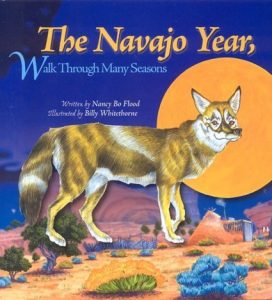 For the Navajo people, the new year begins in October, when summer meets winter. The Navajo Year, Walk Through Many Seasons follows the Navajo calendar, and provides poetic descriptions of the many sights, sounds, and activities associated with each month. In November, there are string games and stories; in April, planting of corn, beans, and squash; and in July, rodeos and monsoon rains. Follow Coyote through the year, and explore how the Navajos observe the rites and passages of each month.
For the Navajo people, the new year begins in October, when summer meets winter. The Navajo Year, Walk Through Many Seasons follows the Navajo calendar, and provides poetic descriptions of the many sights, sounds, and activities associated with each month. In November, there are string games and stories; in April, planting of corn, beans, and squash; and in July, rodeos and monsoon rains. Follow Coyote through the year, and explore how the Navajos observe the rites and passages of each month.
North America
The Inuit Thought Of It: Amazing Arctic Innovations (We Thought Of It)
 Dazzling inventions from the far north.Today’s Arctic communities have all the comforts of modern living. Yet the Inuit survived in this harsh landscape for hundreds of years with nothing but the land and their own ingenuity. Join authors Alootook Ipellie and David MacDonald as they explore the amazing innovations of traditional Inuit and how their ideas continue to echo around the world.Some inventions are still familiar to us: the one-person watercraft known as a kayak retains its Inuit name. Other innovations have been replaced by modern technology: slitted snow goggles protected Inuit eyes long before sunglasses arrived on the scene. And other ideas were surprisingly inspired: using human-shaped stone stacks (lnunnguat) to trick and trap caribou.Many more Inuit innovations are explored here, including: Dog sleds Kids’ stuff Shelter Food preservation Clothing Medicine.In all, more than 40 Inuit items and ideas are showcased through dramatic photos and captivating language. From how these objects were made, to their impact on contemporary culture, The Inuit Thought of It is a remarkable catalog of Inuit invention.
Dazzling inventions from the far north.Today’s Arctic communities have all the comforts of modern living. Yet the Inuit survived in this harsh landscape for hundreds of years with nothing but the land and their own ingenuity. Join authors Alootook Ipellie and David MacDonald as they explore the amazing innovations of traditional Inuit and how their ideas continue to echo around the world.Some inventions are still familiar to us: the one-person watercraft known as a kayak retains its Inuit name. Other innovations have been replaced by modern technology: slitted snow goggles protected Inuit eyes long before sunglasses arrived on the scene. And other ideas were surprisingly inspired: using human-shaped stone stacks (lnunnguat) to trick and trap caribou.Many more Inuit innovations are explored here, including: Dog sleds Kids’ stuff Shelter Food preservation Clothing Medicine.In all, more than 40 Inuit items and ideas are showcased through dramatic photos and captivating language. From how these objects were made, to their impact on contemporary culture, The Inuit Thought of It is a remarkable catalog of Inuit invention.
Juan Verdades: The Man Who Couldn’t Tell A Lie

A wealthy rancher is so certain of the honesty of his foreman that he wagers his ranch.
Little Princess Ka’iulani
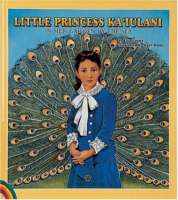
Snuggle up to this story of Hawaii’s special princess, Kaiulani. Follow her adventures as a young girl growing up in Hawaii as part of the royal family. Learn about her special garden by the sea and her friendship with poet, Robert Louis Stevenson. Author Ellie Crowe offers children a rare glimpse of the Hawaiian monarchy, Princess Kaiulani and the customs of the day. The delicate drawings of Mary Koski bring Crowe’s story to life by accurately depicting the architecture and clothing of the time period.
The Story Of Colors / La Historia De Los Colores: A Bilingual Folktale From The Jungles Of Chiapas
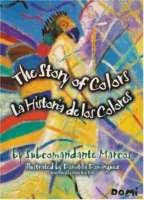
When the NEA -rescinded funding for The Story of Colors, the news hit the cover of the New York Times and made the book an instant bestseller. But far from being subversive, this beautifully illustrated folktale teaches us all about the value of diversity. Old man Antonio tells how a long time ago the world was just black and white and gray. This bored the gods, so they went looking for bright colors and they found them in the most peculiar places!
No one exactly knows who -Subcomandante Marcos is, but since New Year’s Day 1994, when the Zapatistas declared war on the Mexican government, he has become a post-modern revolutionary hero.
Smoke Over Grand Pré
Smoke Over Grand Pré provides a glimpse into the lives of people who lived during the period that led up to the Acadian deportation. The eviction of Acadians from Nova Scotia by the English gove ment represents an important chapter in the history of Nova Scotia and of Canada.
Nutik and Amaroq Play Ball

Amaroq is a lively Eskimo boy who fives at the top of the world with his best friend, Nutik, the wolf pup. Amaroq was named after a great wolf leader; Nutik is the wolf leader’s grandpup. The boy and the wolf pup are like brothers.One day Amaroq and Nutik want to play football, but their ball has disappeared. What shall they do? Listening to and observing Nutik’s wolf talk, Amaroq follows him outside. The two friends wander out onto the tundra, where there are no trees, no paths, and no landmarks to help them find their way home again. Amaroq is afraid they are lost, but then he remembers what the great wolf leader he was named after would do. By observing nature and following what it says, Amaroq and Nutik are safe again-but not before finding a surprise for both of them!Amaroq and Nutik’s adventure follows the first picture book about them, Nutik, the Wolf Pup, and continues the Arctic saga about these characters originally drawn from Julie’s Wolf Pack, sequel to the Newbery Medal-winning Julie of the Wolves.
The Inuit (First Americans)

Provides comprehensive information on the background, lifestyle, beliefs, and present-day lives of the Inuit people.
Nutik, The Wolf Pup
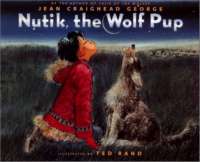
In an Eskimo village at the top of the world lived a little boy whose name was Amaroq. Named for the great wolf leader who saved the life of his big sister, Julie, Amaroq loved wolves as much as his big sister did.
One day Julie brings home a sickly wolf pup named Nutik for Amaroq to feed and tend. “Don’t fall in love with Nutik,” Julie warns, “or your heart will break when the wolves come to take their pup home.” Amaroq feeds and cares for Nutik, and soon the fuzzy little pup is romping and playing and following Amaroq everywhere. Amaroq and Nutik become best friends, but soon it’s time for Nutik to rejoin his wolf family. Will Amaroq be strong like the great wolf leader he was named after and be able to let Nutik go?
In this adventure-first told in Julie’s Wolf Pack, sequel to the Newbery Medal-winning Julie of the Wolves Jean Craighead George brings the Arctic world of Julie and her family to a picturebook audience.
Yamozha And His Beaver Wife
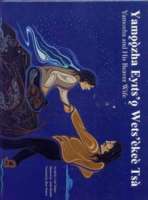
In this legend, Yamozha forgets his promise to his wife and as a result she turns into a giant beaver. He follows her all over Denedeh but is unable to catch her. This story tells of how this great medicine man shaped the land in the Tlicho region and its surrounding areas into what it is today.
